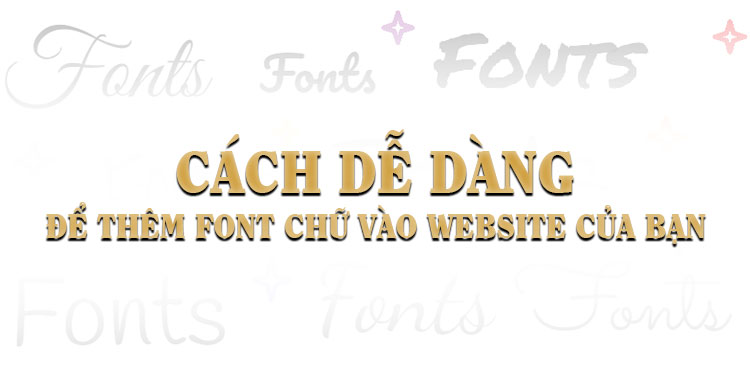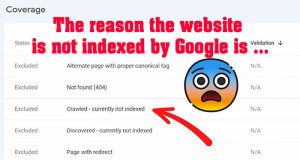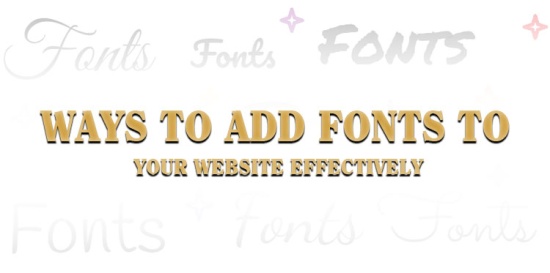Effective ways to add fonts to your website
Which fonts can be used on the Web?
There are many types of fonts that can be used on the web, including system fonts, custom fonts, and fonts from external services. Below are the common types of fonts that can be used on the web:
1. System Fonts
These are the default fonts on the user's operating system and do not require downloading. They help save page load time and ensure broad compatibility.
- Windows: Arial, Times New Roman, Verdana, Tahoma, Courier New
- macOS: Helvetica, Arial, Times, Courier, Georgia
- Linux: DejaVu Sans, Ubuntu, Liberation Sans
2. Web Safe Fonts
These are fonts that are widely used across operating systems and browsers, ensuring the best compatibility.
- Serif: Times New Roman, Georgia, Palatino
- Sans-serif: Arial, Helvetica, Verdana, Tahoma, Trebuchet MS
- Monospace: Courier New, Lucida Console, Consolas
- Cursive: Comic Sans MS, Brush Script
- Fantasy: Impact, Papyrus
3. Web Fonts
These are fonts not available on the system but can be downloaded from external services like Google Fonts, Adobe Fonts (formerly Typekit), or other font libraries.
- Google Fonts: A free service offering thousands of custom fonts for the web. Some popular fonts:
- Roboto
- Open Sans
- Lora
- Montserrat
- Poppins
- Adobe Fonts: A paid service offering high-quality fonts from Adobe. Notable fonts:
- Proxima Nova
- Source Sans Pro
- Roboto Condensed
- Fira Sans
4. Self-hosted Fonts
For custom fonts not available on the web, you can upload font files like TTF, OTF, WOFF, or WOFF2 and use them on your website through the @font-face property in CSS. This is a common way to use brand fonts or proprietary fonts.
5. SVG Fonts
SVG fonts are a type of font based on vector graphics (SVG), but they are rarely used due to compatibility and performance issues.
6. Icon Fonts
Icon fonts like Font Awesome, Material Icons, or IcoMoon provide icons in the form of fonts, allowing easy and flexible use in websites.
Summary:
- System fonts and web-safe fonts are common choices for websites needing broad compatibility and fast loading times.
- Web fonts and self-hosted fonts are ideal when you need to use custom, unique fonts for your website.
- Icon fonts are suitable when you need to use icons in the form of fonts.
The choice of font depends on the design requirements, page load speed, and compatibility of the web project.
Different Font Formats and Browser Support
1. TrueType Fonts (TTF)
- Description: Developed by Apple and Microsoft, TTF is one of the most popular font formats.
- Browser support:
- Chrome: Supported
- Firefox: Supported
- Safari: Supported
- Edge: Supported
- Internet Explorer: Supported
2. OpenType Fonts (OTF)
- Description: Similar to TTF, OTF was developed by Microsoft and Adobe, and supports more advanced features, including special characters.
- Browser support:
- Chrome: Supported
- Firefox: Supported
- Safari: Supported
- Edge: Supported
- Internet Explorer: Supported
3. Web Open Font Format (WOFF)
- Description: Optimized for the web, WOFF provides a compressed version of TTF and OTF, reducing file size and increasing page load speed.
- Browser support:
- Chrome: Supported
- Firefox: Supported
- Safari: Supported
- Edge: Supported
- Internet Explorer: Supported (with WOFF 1.0)
4. Web Open Font Format 2 (WOFF2)
- Description: An improved version of WOFF with a higher level of compression, further reducing file size.
- Browser support:
- Chrome: Supported
- Firefox: Supported
- Safari: Supported
- Edge: Supported
- Internet Explorer: Not supported
5. Embedded OpenType (EOT)
- Description: Developed by Microsoft, EOT is a font format primarily used in older versions of Internet Explorer.
- Browser support:
- Chrome: Not supported
- Firefox: Not supported
- Safari: Not supported
- Edge: Not supported
- Internet Explorer: Supported
6. SVG Fonts
- Description: SVG fonts are an XML-based format that uses vector graphics to display characters. However, they are less commonly used in web design due to compatibility and performance issues.
- Browser support:
- Chrome: Not supported
- Firefox: Not supported
- Safari: Supported
- Edge: Not supported
- Internet Explorer: Not supported
7. CSS Font Face
- Description: This is not a font format, but a method in CSS that allows you to use custom fonts without relying on system fonts.
- Browser support:
- Chrome: Supported
- Firefox: Supported
- Safari: Supported
- Edge: Supported
- Internet Explorer: Supported
Summary
- Modern browsers like Chrome, Firefox, Safari, and Edge support popular font formats such as TTF, OTF, WOFF, WOFF2, and CSS Font Face.
- Older browsers like Internet Explorer may not support newer formats like WOFF2, but work well with TTF, OTF, and EOT.
- To optimize for all users, using font formats like WOFF and WOFF2 combined with CSS Font Face is the most common and effective solution today.
Ways to Add Fonts to Your Website
There are many easy ways to add fonts to your website. Below are the common methods:
1. Using Google Fonts
Google Fonts offers thousands of free fonts that can easily be integrated into your website. This is the most popular and simplest way to use custom fonts.
How to do it:
- Go to Google Fonts.
- Search for and select the font you want to use.
- Choose the font variants (if needed).
- Copy the CSS embed code from the "Embed" section on the Google Fonts page.
- Paste the embed code into the
<head>section of your HTML file:
<head>
<link href="https://fonts.googleapis.com/css2?family=Roboto:wght@400;700&display=swap" rel="stylesheet">
</head>
- In your CSS file, use the added font:
body {
font-family: 'Roboto', sans-serif;
}
2. Using Adobe Fonts (Typekit)
Adobe Fonts offers a collection of high-quality, professional fonts. You need an Adobe account to use this service.
How to do it:
- Go to Adobe Fonts.
- Select the font you want and create a font kit.
- After creating the font kit, you will receive an embed code.
- Copy the embed code and paste it into the
<head>section of your HTML:
<head>
<link rel="stylesheet" href="https://use.typekit.net/xxxxxx.css">
</head>
- In your CSS, use the font as follows:
body {
font-family: 'FontName', sans-serif;
}
3. Using Fonts from Uploaded Files (Self-hosted Fonts)
If you have font files (like TTF, OTF, WOFF, WOFF2), you can upload them to your server and use them through @font-face in CSS.
How to do it:
- Upload the font files to a directory on your server (e.g.,
/fonts/). - Add the
@font-facerule to your CSS file:
@font-face {
font-family: 'CustomFont';
src: url('/fonts/CustomFont.woff2') format('woff2'),
url('/fonts/CustomFont.woff') format('woff');
font-weight: normal;
font-style: normal;
}
body {
font-family: 'CustomFont', sans-serif;
}
4. Using Icon Fonts (e.g., Font Awesome)
If you want to add icons as fonts, you can use services like Font Awesome or Material Icons.
How to do it:
- Go to Font Awesome or Material Icons.
- Copy the embed code and paste it into the
<head>section of your HTML:
<head>
<link rel="stylesheet" href="https://cdnjs.cloudflare.com/ajax/libs/font-awesome/6.0.0-beta3/css/all.min.css">
</head>
- Use the icon in your HTML:
<i class="fas fa-home"></i>
5. Using CSS @import
If you want to embed fonts in your CSS without adding them to the HTML, you can use @import.
How to do it:
- Copy the URL of the font from Google Fonts or another service.
- Add the
@importcode at the beginning of your CSS file:
@import url('https://fonts.googleapis.com/css2?family=Roboto:wght@400;700&display=swap');
body {
font-family: 'Roboto', sans-serif;
}
Summary:
- Google Fonts and Adobe Fonts are simple and easy ways to add fonts to your website.
- Self-hosted fonts allow you to use custom fonts without relying on external services.
- Icon Fonts like Font Awesome are a great choice for using icons.
- CSS @import is an alternative method for embedding fonts from external services without modifying HTML.
Choose the method that best suits your needs and ensure that the font you use provides the best user experience!
Conclusion
Regardless of your experience with CSS, following the instructions in this article will enable you to add any font to any website-building platform.
However, once you've successfully added the font you want to your website, the questions you need to ask yourself are:
Can you customize the appearance of the font? (font weight, color, line height, letter spacing, opacity, etc.) Can you customize the layout of your website to make the font stand out (text positioning, images, videos, etc.)?
If you don't have much experience with CSS, these customizations can be challenging when using a CMS or a rigid template-based website builder like SquareSpace. This is why I recommend using a flexible website builder like Pagecloud.
This builder offers unmatched flexibility when you want to create a unique layout with virtually unlimited font and style options. Sign up today to try Pagecloud's eCommerce platform and build your website!













